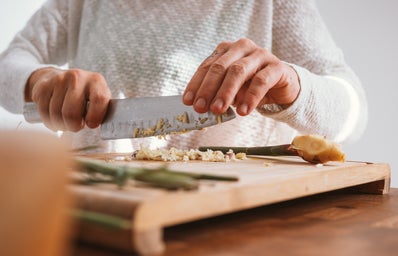So you spent your first year (or two) living in on-campus housing with all your dining needs taken care of, and now you’ve got your first apartment. Maybe it’s still close to the dining halls and campus restaurants, but you want to save a few hundred dollars and cook for yourself. This brief guide will help you stock your pantry with food that’s affordable, tasty, and most importantly, you’ll actually use these before they expire.
This is not a complete list, but it serves as a good baseline so that you can pick up a couple of fresh things from the store and be ready to make multiple delicious meals with them at a moment’s notice. Happy cooking!
EQUIPMENT
Before you get started on buying food, you’re going to need a few things to be able to prepare it. None of this is very expensive and all of it is going to be used very often for a long time.
Knife: Get yourself a decent 8-inch chef’s knife, and it will last you a few decades at least. The brand Dexter-Russell makes good quality knives for a bargain price. You’re going to use this for just about everything you cook for the rest of your life, so don’t be dismayed at the cost. The 8-inch size makes it big enough for any college student’s prep task while still being maneuverable for any hand size.
Honing Rod: This will keep your knife sharp with just a few passes before every cutting task. A sharp knife makes the kitchen work faster and safer, so be sure to brush up on how to use a honing rod to elevate your cooking game.
Cutting Board: You don’t need a fancy wooden cutting board to do the trick, but you do need to ditch the thin plastic and glass ones that will just damage your knife blade. A good cutting board needs to be thick and softer than the knife so that the board isn’t wearing your blade down every time you use it.
Small Saucepan (and lid): If you’re just cooking for yourself and sometimes a roommate, all you really need is a 2- or 3-quart saucepan with a lid. This will boil your pasta water, heat up soups, and cook your rice.
Frying pan: A lot of websites will tell you that you absolutely need a cast iron pan. It’s true; it’s a very versatile pan for serious cooking, but it’s a pain to maintain for college students in a smaller kitchen. A cheap nonstick pan or two will work just fine for your frying needs. Just make sure it’s big enough to hold a few servings of food but not so wide that it extends far beyond your burner size.
PANTRY GOODS
This is going to be the stuff you can keep out at room temperature. Most of it is very cheap and it’ll last a long time, meaning you don’t have to worry about using all of it quickly.
Dried Pasta: This is a staple if you love pasta as much as I do, and one of the easiest bases for meals you’ll have. I like to have spaghetti on hand for red sauce or vodka sauce, cavatappi for an amazing mac n cheese or butter garlic noodles on lazier days, and some thick rice noodles for peanut sauce rice noodles. But, this can be any kind of pasta that suits your personal tastes.
Pasta Sauce: I personally would recommend making your own pasta sauce, but it’s always worth having some kind of sauce on hand. It makes a great quick dinner and is easy to make for a group. If you must get it from the store, I suggest Rao’s brand.
Peanut Butter: This is just about the cheapest food per calorie, and it’s a good source of protein for students who don’t eat meat. I love using peanut butter to make sauces for noodles as well as tossing it on toast or oatmeal to fill my stomach for the long days on campus.
Cooking Oil: Canola oil is great to have on hand for cooking, and it lasts a long time. If you’re feeling really creative, you can combine it with an egg and a few other ingredients to make homemade mayo that’s much better than the store-bought version.
Honey: Honey doesn’t go bad, so it’s worth having on hand, even if you don’t use it very often. It’s great in both tea & sauces, and it can help soothe a sore throat during the colder months.
Burrito Tortillas: These are so versatile for making quick meals or snacks. You can use them to make a simple quesadilla and for on-the-go lunch or dinner wraps. Just remember to toss them in the fridge once opened.
Pancake Mix: Just add water and you’re ready. It doesn’t get much easier than that when you don’t have the energy for breakfast as you see during the opening scene of a coming-of-age movie.
Rice: This is one of the best bases for meals you can have. It keeps for a long time when kept in an airtight container. It’s cheap to buy in bulk, and it goes with just about anything you want on there. You can toss whatever veggies and proteins you have on hand into a pan with rice, mix it with a sauce, and you’ve got something delicious. It also is great the day after as fried rice.
FOR THE FRIDGE
Milk: It doesn’t have to be cow’s milk, but you should always have your milk of choice on hand. Besides being used for cereal, this can be used for several sauces, including a bechamel for creamy mac & cheese.
Block Cheese: If you own a cheese grater, block cheese is much better than buying pre-grated bags of cheese. Not only is it cheaper by volume, but freshly grated cheese will also always taste and melt better because it isn’t coated with anti-clumping agents found in the bagged kind. Use it for mac & cheese, omelets, quesadillas, or your snack of choice.
Eggs: If you’re not vegan, having eggs is always a great idea. It’s one of the cheapest sources of protein and fats and will prepare you for a long day of classes better than a bowl of cereal. If you don’t typically like the taste of eggs, try different methods of cooking eggs, like poached or soft-boiled.
With all of these kitchen tools and food basics, you’ll be ready to up your cooking game and make sure you are eating enough during the school year!


